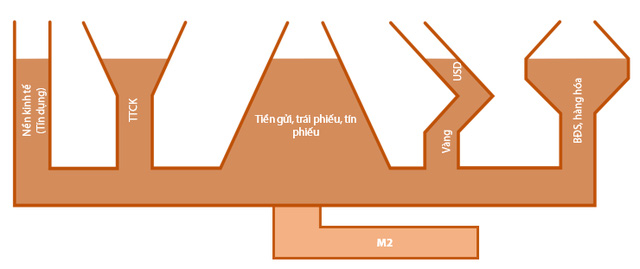|
Stock market expected to be strong in
2017
Thanks to the
monetary policy maintained by the State Bank (SBV) in 2016, cash flow to the
stock market was strong, which helped support the VN Index. Will the same
trend occur in 2017?
 Experts said the financial-monetary market operates in accordance with the ‘communicating vessels’ principle. The liquidity surplus will encourage cash flow to squeeze into different investment channels, including the stock market. Reports have found close relations between the difference in money supply increase and credit, and the growth of the VN Index. In July 2013-January 2014, November 2014-February 2015 and November 2015-September 2016, when the difference in money supply increase and credit widened, the VN Index also increased, and vice versa.
Amid the
worry about weak capital flow from overseas as the US FED may continue
raising prime interest rate, domestic capital will be considered the major
‘fuel’ for the stock market in 2017.
The government’s targets for money supply and credit growth in 2017 seem to be the same as 2016. However, it is more cautious setting the credit growth rate target of 18 percent for 2017, lower than the 18-20 percent growth rate target for 2016. Rong Viet Securities (VDSC) believes that the loose monetary policy will still be maintained in 2017. It pointed out that the risks for the monetary policy management in 2017 include the inflation rate risk and the US FED’s plan to raise the prime interest rate. Regarding the inflation risk, the money supply increased very sharply in 2011-2016 with the ratio of M2 on GDP at the record high of 157.6 percent. Credit has also been increasing rapidly with the ratio of credit on GDP at 123 percent. As such, Vietnam’s M2/GDP ratio is the second highest to China. However, regarding the credit scale, Vietnam ranks fourth, after China, Thailand and Malaysia. If compared with previous years, the average M2 and credit growth rates in 2006-2011 were 1.5-2 times higher than that in 2011-2016. VDSC warned that the money pumped into the banking system can be compared to a ‘time bomb’, i.e. the central bank needs to withdraw money from circulation, or asset bubbles will form. Bloomberg has quoted analysts in Vietnam as affirming that the VN Index in 2017 will reach a 10-year high. The recovery of the national economy will attract investors to Vietnam. The 11 experts interviewed by Bloomberg said the VN Index would be climbing to 745 points by the end of 2017 or increasing by 12 percent compared with the end of 2016, higher than the predicted 10 percent growth rate of MSCI AC Asean.
Thanh
Lam,
VNN
|
Thứ Hai, 6 tháng 2, 2017
Đăng ký:
Đăng Nhận xét (Atom)
Không có nhận xét nào:
Đăng nhận xét